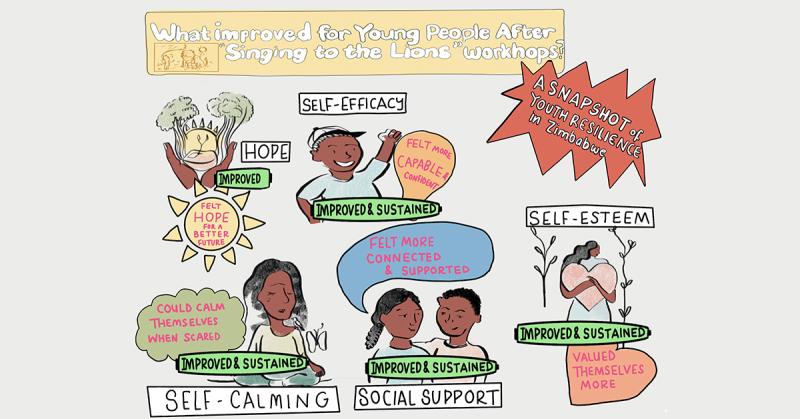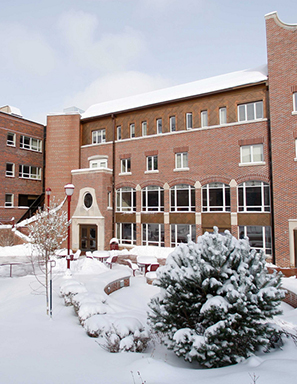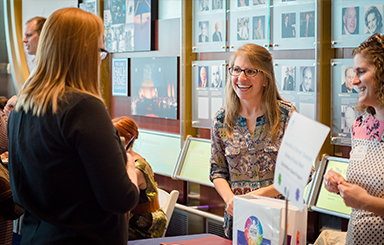Advancing Anti-Oppressive and Anti-Extractive Research
Fisher ultimately added a year to her undergraduate education to double major in social work. With an undergraduate social work degree, Fisher recalls, “I felt like I was making a contribution, but I wasn’t able to contribute to really changing anything … It felt like putting Band-Aids on bigger problems, and I wanted to know how to address those bigger problems.” Fisher went on to earn an MSW from Michigan State University and a PhD from the Brown School of Social Work at Washington University in St. Louis.
As a first-generation college student, Fisher had little knowledge of what a PhD entailed and never envisioned becoming a global health equity scholar with more than $2 million in research awards. Among Fisher’s extensive funding was a 2021 Fulbright-Nehru Faculty Scholar research award to advance understanding of microfinance self-help groups as a poverty alleviation strategy for rural women in India.
Prior to joining GSSW, Fisher was a social justice and research scientist with the University of Alabama at Birmingham and was affiliated with the university’s Minority Health & Health Equity Research Center, School of Medicine Center for AIDS Research, and Sparkman Center for Global Health. Fisher also served as the MSW program director for the University of Alabama at Birmingham Department of Social Work.
Fisher’s early career research was focused on health equity in the United States; however, a 2012 trip to Kenya to develop a study abroad program marked a significant change of course. In meeting with nongovernmental organizations (NGOs), Fisher recalls, “I saw how so many of them had implemented these really innovative interventions to address the issues that they identified in their community. They were having a tremendous impact, but all they had to show for their impact was stories.” Organizations told Fisher they couldn’t get funding to sustain their programs because they did not have the types of evaluation data funders want. “I realized that these are organizations doing amazing work, and they’re doing it on a shoestring budget in really difficult circumstances, in low-resource contexts. They don’t need to import interventions from the West, which is the traditional global health model that adheres to traditional colonial systems of power and transfer of knowledge and resources.”
Fisher’s research has had a global focus ever since. Fisher says, “As I meet different organizations, the question I ask is, how can I bring my research skills to come alongside them as a partner to achieve what it is that they want to achieve? So instead of having my own research agenda, I partner to create research that helps organizations get the data that they need to evaluate intervention effects, demonstrate organizational impact, and help bridge the divide between interventions created in the Global South and the Global North-dominated prevention science.”
One such project was a two-year, mixed-method randomized controlled trial in Zimbabwe that used a community-based participatory research approach. In collaboration with NGO Miracle Missions Vimba, University of Zimbabwe education faculty, and funder Catholic Relief Services, the study tested the impact of Singing to the Lions (STL), a three-day biopsychosocial intervention designed in Zimbabwe for Zimbabwean youth who had experienced trauma. Fisher notes, “People have used [the intervention] all over the world, but there had never been a rigorous evaluation of it. This was the first research to ever assess the impact, and so it feels like that’s really important to scale up. It’s not just about improving resilience for trauma-affected youth in Zimbabwe, but if what they’re doing in Zimbabwe can also help youth not just in neighboring Zambia but also in India or Guatemala or elsewhere, that to me is something worth investing substantial time into.”
Participants included over 1,300 youth in urban and rural settings who answered questions about their characteristics, symptoms associated with trauma, and indicators of resilience. Youth answered questions before attending an STL workshop at school, immediately after the workshop and three months later. Parents and caregivers also took part in the study through a participatory method called Most Significant Change. Through qualitative interviews, parents and caregivers told stories about changes they had observed in their children after the STL workshops, then these stories were analyzed by a group of local teachers who selected the stories they determined were most significant through a local community lens. Also in the study’s qualitative phase, a subsample of children were asked to draw a picture of themselves along with people, places or things that help them to “sing to their lions” (that is, face their fears) followed by a brief interview. Drawings were then analyzed by a bilingual local team to identify key intervention impacts from children’s perspective.
Fisher reports that youth workshop participants had significantly more self-esteem, self-efficacy and hope for the future than those in the waitlist control group. They also expressed a greater ability to self-calm and greater social support. Fisher says that overall, “Our results suggest that STL is effective for youth with a variety of different characteristics and backgrounds.” That sort of data, in turn, “expands the NGO’s reach and it expands their capacity to obtain funding to make their important work sustainable.”
To expand use of such anti-extractive research approaches, Fisher co-authored “Using Bottom-Up Evaluation to Build Community Practice-Based Evidence and Strengthen Community-Engaged Research,” published in the Journal of Community Practice. Fisher explains, “Bottom-up evaluation is about partnering with organizations to evaluate community-driven interventions that are already showing promise locally to build evidence from the ground up rather than importing existing evidence-based interventions and trying to tailor them to fit the local context. There are some criteria for determining whether community-created interventions are ready to be evaluated and whether the organization itself has the capacity — or can develop the capacity — to partner on an evaluation. And if the organization and researcher decide together to conduct a bottom-up evaluation, the organization gets information about the effectiveness of their program that’s so important for funders and other stakeholders. Where bottom-up evaluation differs from traditional program evaluation is that you are conducting the research and publishing findings with the explicit intention of bringing locally generated interventions into the scientific evidence base.”
For the STL evaluation project, dissemination efforts include not only academic journal articles and conference presentations co-authored with community partners, but also a public-facing website, a series of comic-style reports published in English and Shona (the primary language spoken in Zimbabwe) and forthcoming magazine-style articles and infographics written for non-research audiences.
Fisher adds, “From the beginning, you’re planning to inform the field so that this local intervention now becomes part of the scientific evidence base; it’s shifting the conceptualization of what is ‘evidence-based’ from predominantly Western and Global North focused evidence to actual global evidence.”





